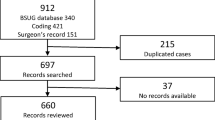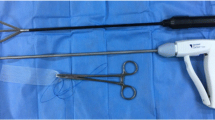Abstract
Purpose
In this study, we sought to confirm the surgical method of vaginal sacrocolporectopexy and previously reported positive perioperative results of this procedure in a large patient group. We describe the approach which offers a vaginal, safe alternative to sacrospinous repair, laparoscopic or open vaginosacropexy and the use of synthetic meshes to treat pelvic organ prolapse.
Methods
We conducted a monocentric, prospective, nonrandomized study for treatment of patients with uterine and vaginal vault relapse (grade 2–4). All patients underwent a preoperative urogynecological urodynamic examination. We focus on method, operative time, complications, blood transfusions, hospital stay and clinical data.
Results
Between March 2006 and March 2011, 101 consecutive patients of mean age 64 (40–89) years, with sub or total uterine prolapse (n = 69, grade 2–4) and vaginal vault prolapse (n = 32, grade 2–4) were treated with vaginal sacrocolporectopexy. Cystocele (grade 2–4) was found in 88 (87.1 %) and rectocele (grade 2–4) in 43 (42.5 %) patients. Mean duration of surgery with sacrocolporectopexy was 70 min (28–165) without hysterectomy, and 76 min (40–219) with hysterectomy. Regression analysis of all patients (n = 101) showed a significant decrease of operative time in the group without hysterectomy after 40 cases. Three bladder lesions, two in patients with a history of hysterectomy, occurred during surgery and were corrected intraoperatively without further complications. No patient required a blood transfusion. Hemoglobin levels decreased slightly from a preoperative mean of 13.6 mg/dl (10.3–15.7) to a postoperative mean of 11.7 mg/dl (8.6–14.7).
Conclusion
Vaginal sacrocolporectopexy is a safe vaginal method for the treatment of sub-/total uterine/vaginal vault prolapse.







Similar content being viewed by others
References
Nygaard IE, McCreery R, Brubaker L, Connolly A, Cundiff G, Weber AM, Zyczynski H, Pelvic Floor Disorders Network (2004) Abdominal sacrocolpopexy: a comprehensive review. Obstet Gynecol 104(4):805–823
Beer M, Kuhn A (2005) Surgical techniques for vault prolapse: a review of the literature. Eur J Obstet Gynecol Reprod Biol 119(2):144–155
Roovers JP, van der Bom JG, van der Vaart CH, van Leeuwen JH, Scholten PC, Heintz AP (2005) A randomized comparison of post-operative pain, quality of life, and physical performance during the first 6 weeks after abdominal or vaginal surgical correction of descensus uteri. Neurourol Urodyn 24(4):334–340
Hsiao KC, Latchamsetty K, Govier FE, Kozlowski P, Kobashi KC (2007) Comparison of laparoscopic and abdominal sacrocolpopexy for the treatment of vaginal vault prolapse. J Endourol 21:926–930
Salvatores M, Pellegrini P, Botchorishvili R, Canis M, Pouly JL, Mage G, Wattiez A (2006) Laparoscopic promontal fixation: assessment of 100 cases. Minerva Ginecol 58:405–410
Banerjee C, Noé KG (2008) Laparoscopic sacropexy—an underestimated method of vaginal vault surgery. Geburtsh Frauenheilk 68:492–496
Banerjee C, Leufgen H, Hatzmann W, Noé G (2010) Complications, re-prolapse rates and functional results after laparoscopic sacropexy: a cohort study. Geburtsh Frauenheilk 70:379–384
Volz J, Strittmatter E, Volz E, Wischnik A, Melchert F (1993) Die pelviskopische Sakropexie zur Therapie des Vaginalprolapses. Geburtsh u Frauenheilk 53:705–708
Zempel W, Gösling A, Hillemanns P, Hertel H (2010) Successful pregnancy after laparoscopic uterosacropexy in a young woman with total uterine prolapse. Arch Gynecol Obstet 282(Suppl 1):66 (abstract)
Baumann M, Salvisberg C, Mueller M, Kuhn A (2009) Sexual function after sacrospinous fixation for vaginal vault prolapse: bad or mad? Surg Endosc 23(5):1013–1017
de Tayrac R, Devoldere G, Renaudie J, Villard P, Guilbaud O, Eglin G (2007) Prolapse repair by vaginal route using a new protected low-weight polypropylene mesh: 1-year functional and anatomical outcome in a prospective multicentre study. Int Urogynecol J Pelvic Floor Dysfunct 18:251–256
de Tayrac R, Deffieux X, Gervaise A, Chauveaud-Lambling A, Fernandez H (2006) Long-term anatomical and functional assessment of trans-vaginal cystocele repair using a tension-free polypropylene mesh. Int Urogynecol J Pelvic Floor Dysfunct 17:483–488
Benhaim Y, de Tayrac R, Deffieux X, Gervaise A, Chauveaud-Lambling A, Frydman R, Fernandez H (2006) Treatment of genital prolapse with a polypropylene mesh inserted via the vaginal route. Anatomic and functional outcome in women aged less than 50 years. J Gynecol Obstet Biol Reprod (Paris) 35:219–226
Abramov Y, Gandhi S, Goldberg RP, Botros SM, Kwon C, Sand PK (2005) Site-specific rectocele repair compared with standard posterior colporrhaphy. Obstet Gynecol 105:314–318
Amrute KV, Eisenberg ER, Rastinehad AR, Kushner L, Badlani GH (2007) Analysis of outcomes of single polypropylene mesh in total pelvic floor reconstruction. Neurourol Urodyn 26:53–58
Baessler K, Hewson AD, Tunn R, Schuessler B, Maher CF (2005) Severe mesh complications following intravaginal slingplasty. Obstet Gynecol 106:713–716
Deffieux X, de Tayrac R, Huel C, Bottero J, Gervaise A, Bonnet K, Frydman R, Fernandez H (2007) Vaginal mesh erosion after transvaginal repair of cystocele using Gynemesh or Gynemesh-Soft in 138 women: a comparative study. Int Urogynecol J Pelvic Floor Dysfunct 18:73–79
Foulques H (2007) Tolerance of mesh reinforcement inserted through vaginal approach for the cure of genital prolapses. A 317 continuous case study. J Gynecol Obstet Biol Reprod (Paris) 36(7):653–659
Hefni M, Yousri N, El-Toukhy T, Koutromanis P, Mossa M, Davies A (2007) Morbidity associated with posterior intravaginal slingplasty for uterovaginal and vault prolapse. Arch Gynecol Obstet 276:499–504
Lim YN, Muller R, Corstiaans A, Hitchins S, Barry C, Rane A (2007) A long-term review of posterior colporrhaphy with Vypro 2 mesh. Int Urogynecol J Pelvic Floor Dysfunct 18:1053–1057
Maher C, Baessler K, Glazener CM, Adams EJ, Hagen S (2007) Surgical management of pelvic organ prolapse in women. Cochrane Database Syst Rev 14(4):CD004014
Maher C, Feiner B, Baessler K, Glazener C (2011) Surgical management of pelvic organ prolapse in women: the updated summary version. Cochrane review. Int Urogynecol J 22:1445–1457
Kavallaris A, Köhler C, Diebolder H, Vercellino F, Krause N, Schneider A (2005) Repair of prolapse with vaginal sacrocolporectopexy: technique and results. Eur J Obstet Gynecol Reprod Biol 122(2):237–242
von Lengerken J, Hildebrandt T, Diebolder H, Hillemanns P, Runnebaum IB, Hertel H (2006) Hohe Patientenzufriedenheit nach vaginaler Sakrokolporektopexie zur Prophylaxe oder Therapie des Scheidenstumpf-Descensus. Geburtsh Frauenheilk 67 (abstract)
Hertel H, Kotsis S, Grüßner S, Hillemanns P (2010) Two-year follow up of 83 patients treated with vaginal sacrocolporectopexy for sub-/total uterine and vaginal vault prolapse. Arch Gynecol Obstet 282(1):58 (abstract)
Bump RC, Mattiasson A, Bo K, Brubaker LP, DeLancey JO, Klarskov P, Shull BL, Smith AR (1996) The standardization of terminology of female pelvic organ prolapse and pelvic floor dysfunction. Am J Obstet Gynecol 175:10–17
Ganatra AM, Rozet F, Sanchez-Salas R, Barret E, Galiano M, Cathelineau X, Vallancien G (2009) The current status of laparoscopic sacrocolpopexy: a review. Eur Urol 55(5):1089–1103
North CE, Ali-Ross NS, Smith AR, Reid FM (2009) A prospective study of laparoscopic sacrocolpopexy for the management of pelvic organ prolapse. BJOG 16(9):1251–1257
Shiozawa T, Huebner M, Hirt B, Wallwiener D, Reisenauer C (2010) Nerve-preserving sacrocolpopexy: anatomical study and surgical approach. Eur J Obstet Gynecol Reprod Biol 152(1):103–107
de Vries MJ, van Dessel TH, Drogendijk AC, de Haas I, Huikeshoven FJ (1995) Short-term results and long-term patients’ appraisal of abdominal colposacropexy for treatment of genital and vaginal vault prolapse. Eur J Obstet Gynecol Reprod Biol 59:35–38
Cosson M, Rajabally R, Bogaert E, Querleu D, Crepin G (2002) Laparoscopic sacrocolpopexy, hysterectomy, and burch colposuspension: feasibility and short-term complications of 77 procedures. JSLS 6:115–119
Price N, Slack A, Jackson SR (2011) Laparoscopic sacrocolpopexy an observational study of functional and anatomical outcomes. Int Urogynecol J 22:77–82
Akladios CY, Dautun D, Saussine C, Baldauf JJ, Mathelin C, Wattiez A (2010) Laparoscopic sacrocolpopexy for female genital organ prolapse: establishment of a learning curve. Eur J Obstet Gynecol Reprod Biol 149(2):218–221
Conflict of interest
None.
Author information
Authors and Affiliations
Corresponding author
Rights and permissions
About this article
Cite this article
Hertel, H., Grüßner, S., Kotsis, S. et al. Vaginal sacrocolporectopexy for the surgical treatment of uterine and vaginal vault prolapses: confirmation of the surgical method and perioperative results of 101 cases. Arch Gynecol Obstet 286, 1463–1471 (2012). https://doi.org/10.1007/s00404-012-2495-z
Received:
Accepted:
Published:
Issue Date:
DOI: https://doi.org/10.1007/s00404-012-2495-z




